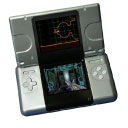 We
We
see huge growth in the handheld game market. It’s a market that has
three or four segments: dedicated game-only handhelds such as Nintendo’s
Game-boy, mobile phone game machines like Nokia’s N-Gage, PDA game machines
like Tapwave’s, and a new category: x86 machines like VIA’s reference
design, Eve.
Each of these segments has different platform opportunities and challenges
for the game developers, and the only potential common denominator on
the horizon is OpenGL ES (see table below for a comparison of the game
platforms).
 One
One
of the most popular handheld game machines in the world is Nintendo’s
Gameboy and Gameboy Advance (see photo). But Nintendo’s president in
the U.S. bragged that eight companies have come after Nintendo’s stronghold
in the dedicated handheld game machine market, and they are all goneÑand
here comes the ninth (i.e., Sony).
The existing dedicated handheld game machines, like Nintendo’s, do
not have a common API, but future products like Sony’s PSP, Tigertelematics’s
Gizmondo, and maybe Nintendo’s DS might use OpenGL. Until that happens,
not all game developers will be able to participate in all platforms.
Cross-platform game porting isn’t as easy to do as it is to say, which
is why you don’t see much of it. A few game developer companies do multiple
con-sole platform offerings at the same time, but you’d be hard-pressed
to find many games that can run on more than one handheld device.
However, the new generation of devices will change that. As the processors
in them get more powerful and use more common operating systems, and
as OGL ES grabs hold due to the efforts of the Khronos group, game developers
will be able to expand their reach.
Existing suppliers like Nintendo and Sony will make their games cross
platform between the console and handheld. That will have a slightly
negative effect for Sony because the company will drain off a little
of its PS2 game sales when it brings out the PSP with many of the same
titles that are available on the PS2. None-theless, the handheld game
market is shaping up to be one of the hot growth areas.
 No
No
longer a child’s toy for entertainment on trips and school buses, the
quality, complexity, and variety of games available for the various
handheld machines will soar in the next couple of years. Mobile phones
and PDAs are approaching the MIPS range of the Xbox and PS2. They already
are capable of running stunning games, especially when equipped with
powerful co-processors or embedded engines. And, all sorts of accessories
for our handheld companions are being developed to make them more like
a game console. Take, for example, the snap-on game-pad controller from
Sony Ericsson for their (and other) phones.

 Nintendo,
Nintendo,
in the meantime, has announced their next-gen handheld, the DSÑDual
Screen. At the press conference the audience went wild with excitement
over the demo, and the president said, “Sony is just entering the
handheld seg-ment and we’ve already raised the bar.” Well, Nintendo
has gone back to the future to raise the bar in order to reinvent the
dual-screen handheld Game-boy DS. The company brought out their first
dual-screen handheld game machine in 1987 with the “Donkey Kong”
hit (see photo).
In addition to longevity, Nintendo has an important component to compete
in the handheld market and that is a community of accessory suppliers.
The Palm community is a prime example, and Nintendo has a small community
of developers too and they are proving themselves to be among the most
innovative and creative of developers.
For example, one of the big developments in handheld games for the
mobile phone and PDA has been Java-based games. Last year, thanks to
Ajile, Java came to the Gameboy Advance. This allowed owners of the
popular handheld to play those quirky Java-based Internet games, as
well as downloading of MP3s. Another example of the potential ubiquity
of the popular handheld is an attachment that comes with a digital camera,
earphone, and microphone from Kyoto-based Digital Act that slips into
the top of the Gameboy Advance just like any video-game cassette. And
when it’s connected to an analog telephone outlet, the display shows
live video of the person on the other end of the line (who must also
own the Gameboy Advance).
Sony and the x86 suppliers will have to foster the same kind of community
if they want to challenge Nintendo, as well as the mobile phones and
PDA suppliers, and we have no doubt they will do exactly that.
The real success will be measured in the number and type of games
that are made available for these new handheld gaming machines. Sony
will shock and awe Nintendo with their roll out of games, Nintendo will
stun Sony with their resilience, the world will gasp at the huge number
of games that begin to appear for mobile phones, and PDA owners will
reap the rewards of the development in all camps, but the new category
of x86 machines will be the real monster with over 1,000 ready to play
games in stores and home ready to go.
Handhelds? We got game!

|
Feature |
Dedicated |
Dedicated |
Phone |
PDA |
X86 |
|
CPU |
16.7-Mhz ARM7 |
400 MHz Sch2440 |
ARM |
ARM, MIPS, 400-MHz Intel Xscale |
X86 |
|
OS |
NA: op code |
Windows CE |
Symbian |
Palm, Windows Mobile 2003 |
Windows Linux |
|
Screen |
240 x 160, 32K color |
240 x 320 |
176 x 208, 65K color |
240 x 320, 65K color |
VGA |
|
Battery playing games |
15 hours |
4 to 6 hours |
2 to 6 hours |
4 to 8 hours |
6 hours |
|
Size |
82 mm x 144.5 mm x 24.5 mm |
170mm x 74mm x 23mm |
108.6 mm x 53 mm x 18.7 mm |
4.46 x 2.75 x .5 inches |
4 x 5 x 6 inches |